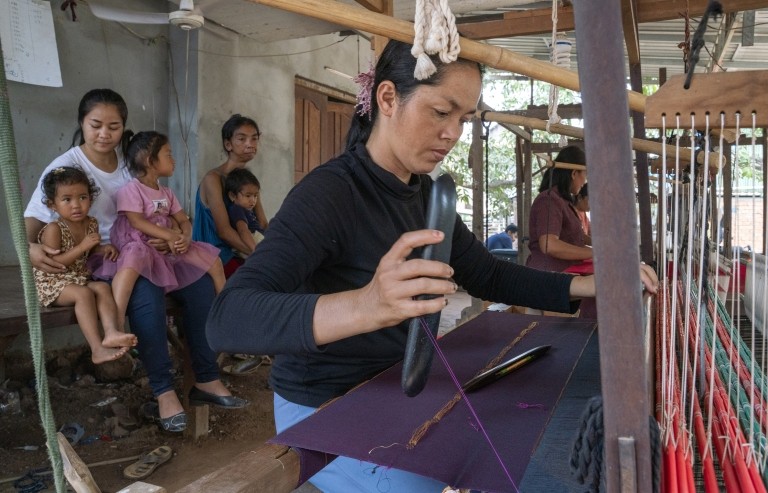Blog
For lasting development solutions, gender equality is key: A Q&A with Pact gender advisor Laurel Bradley

No country, community or economy can achieve its potential or meet today’s challenges without the full and equal participation of all of its citizens. Yet women, girls and non-binary people continue to be left behind in critical ways. While some progress has been made to improve gender equality, significant gaps remain. From gender-based violence and child marriage to disproportionate representation in business and in public decision-making, ending gender inequality must be a priority for the global development community, as it is central to addressing unprecedented, intertwined global challenges.
Dr. Laurel Bradley, a gender equality and social inclusion (GESI) advisor with Pact, supports integrating GESI into governance programming, including efforts to standardize approaches while retaining flexibility that is conducive to including GESI in adaptive management and localization efforts. In this Q&A, she discusses the importance of GESI, how Pact is prioritizing it in our governance work, and more.
Q: Why is gender equality so critical to sustainable global development?
A: Development that does not incorporate the complex realities of social and gender inequality cannot support the empowerment of societies to address their own development challenges. Instead, that kind of programming addresses development challenges in isolation of social contexts. Without intentionally looking at how an entire society is impacted by development challenges, programming falls short, and development outcomes are achieved for only a narrow segment of people. Solutions that only work for some are going to be less sustainable over time. I like to flip the question and ask why wouldn’t gender and social equality be a critical part of development?
Why is deliberate action required to advance gender equality?
In many programs, if GESI is not prioritized, it is not integrated in meaningful ways nor guided by local experts. Program leadership and staff can believe strongly in GESI principles, but must also intentionally dedicate resources to GESI integration.
A locally informed and intentional approach creates space for engaging positively with community dynamics, partnering with the people already engaged in this work and supporting the momentum that already exists for addressing gender and social inequalities. This allows for more valuable community and stakeholder engagement, more impactful activity design and more sustainable solutions.
"Solutions that only work for some are going to be less sustainable over time."
What are the biggest current challenges to achieving gender equality and social inclusion?
Despite important gains, GESI integration is not yet normalized as a necessary and obvious part of how development programs should be planned and implemented. There has been progress to integrate gender and inclusion in the processes of how development work is done, including through awareness raising, policies, USAID’s ADS 205 guidance, mainstreaming gender analysis and by promoting evidence for why development initiatives have better outcomes when gender and inclusion are integrated. But the notion that certain projects “aren’t GESI projects” is still pervasive.
GESI can still be treated as an “extra” effort outside of normal programming that has to be accounted for, rather than a key part of how the work is properly done. I’ve had great experiences at Pact with program teams wanting to integrate GESI from the proposal stage throughout the life of the project. But no matter how dedicated program teams are, there is still a siloing effect across the international development sector that can make it hard to fully articulate why GESI approaches are development approaches, and not something separate.
In the realm of governance, what is most critical for sustainable progress in GESI?
Finding and then leveraging productive synergies. Pact’s recently concluded WE Act project in Cambodia is a good illustration of integrating approaches to women’s economic empowerment and rights-based advocacy. The project saw that women’s economic status impacts their engagement in civic spaces, and their ability to claim their socio-economic rights can strengthen their entrepreneurship efforts. The program created a model where economic strengthening activities for young women entrepreneurs were linked to civic strengthening interventions, where women entrepreneurs could identify rights-based issues through their role as business owners, and learn advocacy skills that also lowered their discomfort engaging with authorities.
What is one approach that Pact is taking in its governance work?
Pact is continually working to ground GESI through local partners and engagement with key stakeholders. In the USAID Citizen Security Strengthening Activity in the Dominican Republic, the program takes a holistic approach to defining citizen security, looking beyond more traditional security considerations to understanding how women, youth, Dominicans of Haitian descent and other groups experience insecurity, including in systematic forms of exclusion and gender-based violence. In the USAID Sustainable Peace Activity in Ethiopia, our gender and inclusive development assessment pushed to understand the intersectional issues that affect how various social groups are engaged in peacebuilding activities, or not, to develop programming approaches.
Share a key lesson from the global CSM-STAND project so far.
CSM-STAND projects all work in different ways to strengthen civil society and independent media. Yet one of the strengths of CSM-STAND is that there is an Inclusive Development Strategy that cascades down to all programs. Each associate award is required to identify a gender and inclusive development focal point to participate in the CSM-STAND GESI community of practice. This creates touch points for programs to seek support to integrate GESI into their activities, despite differences in how they may operate.
Learn more about Pact’s gender approach.